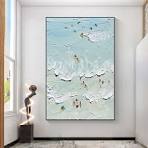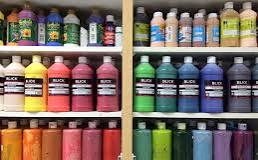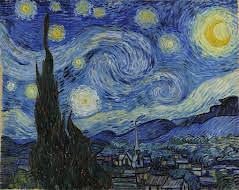The Artistic Brilliance of Middle Eastern Artists
Art has always been a powerful medium for self-expression, cultural reflection, and storytelling. In the diverse and rich tapestry of the Middle East, artists have long played a vital role in shaping the region’s artistic landscape and global influence.
From traditional calligraphy and intricate mosaics to contemporary installations and boundary-pushing sculptures, Middle Eastern artists continue to captivate audiences with their unique perspectives and creative prowess.
Rich Cultural Heritage
The Middle East boasts a rich cultural heritage that serves as a wellspring of inspiration for artists. Drawing from centuries-old traditions, folklore, and historical narratives, Middle Eastern artists infuse their works with a deep sense of identity and belonging.
Innovative Approaches
While honoring their cultural roots, Middle Eastern artists also embrace innovation and experimentation in their artistic endeavors. They blend traditional techniques with modern mediums, creating art that is both timeless and contemporary.
Social Commentary
Many Middle Eastern artists use their art as a platform for social commentary, addressing pressing issues such as identity, politics, gender equality, and human rights. Through their work, they provoke thought, spark dialogue, and challenge societal norms.
Global Recognition
Middle Eastern artists are making significant strides on the global stage, with their works being featured in renowned galleries, museums, and art fairs worldwide. Their art transcends geographical boundaries and cultural barriers, resonating with audiences across the globe.
A Bright Future
As the world continues to appreciate the artistic brilliance of Middle Eastern artists, the future looks promising for this vibrant community of creatives. With each brushstroke, sculpture, or installation, they continue to enrich the world with their talent and vision.
Exploring Middle Eastern Art: Tradition, Innovation, and Global Influence
- What are some traditional art forms practiced by Middle Eastern artists?
- How do Middle Eastern artists blend tradition with innovation in their work?
- What social issues do Middle Eastern artists often address in their art?
- Which famous galleries or museums exhibit works by Middle Eastern artists?
- How has the global art community responded to the work of Middle Eastern artists?
- What cultural influences shape the artistic expression of Middle Eastern artists?
What are some traditional art forms practiced by Middle Eastern artists?
Traditional art forms practiced by Middle Eastern artists encompass a rich tapestry of cultural heritage and artistic expression. Calligraphy, with its intricate and flowing Arabic script, holds a prominent place in Middle Eastern art, serving as a visual representation of language and spirituality. Islamic geometric patterns, found in architecture and decorative arts, showcase the region’s mastery of symmetry and precision. Additionally, miniature painting, storytelling through illuminated manuscripts, and the art of mosaic work are all cherished traditional art forms that continue to inspire and influence Middle Eastern artists today.
How do Middle Eastern artists blend tradition with innovation in their work?
Middle Eastern artists skillfully navigate the delicate balance between tradition and innovation in their work by drawing inspiration from their rich cultural heritage while embracing modern techniques and mediums. They infuse traditional motifs, symbols, and storytelling techniques with contemporary aesthetics, materials, and concepts to create art that is both rooted in the past and relevant to the present. Through this harmonious blend of old and new, Middle Eastern artists not only pay homage to their cultural roots but also push the boundaries of artistic expression, offering fresh perspectives and engaging narratives that resonate with audiences worldwide.
What social issues do Middle Eastern artists often address in their art?
Middle Eastern artists often address a wide range of social issues in their art that reflect the complexities of the region. Themes such as identity, politics, gender equality, cultural heritage, displacement, war, human rights violations, and societal norms are commonly explored through their artistic expressions. By delving into these pressing issues, Middle Eastern artists use their art as a powerful tool for sparking conversations, challenging perceptions, and advocating for positive change within their communities and beyond.
Which famous galleries or museums exhibit works by Middle Eastern artists?
Many famous galleries and museums around the world exhibit works by Middle Eastern artists, showcasing the diverse and vibrant artistic expressions from the region. Institutions such as the Tate Modern in London, the Louvre Abu Dhabi in the United Arab Emirates, the Museum of Modern Art (MoMA) in New York, and the Mathaf: Arab Museum of Modern Art in Doha are known for featuring exhibitions that highlight the talent and creativity of Middle Eastern artists. These renowned cultural institutions provide a platform for artists to share their stories, perspectives, and cultural heritage with a global audience, fostering cross-cultural dialogue and appreciation for art from the Middle East.
How has the global art community responded to the work of Middle Eastern artists?
The global art community has responded to the work of Middle Eastern artists with increasing admiration and recognition. Over the years, there has been a growing appreciation for the unique perspectives, cultural richness, and artistic innovation that Middle Eastern artists bring to the forefront. Their ability to blend traditional techniques with contemporary themes has captivated audiences worldwide, leading to a surge in exhibitions, collaborations, and critical acclaim. Middle Eastern artists have successfully transcended geographical boundaries, sparking meaningful dialogues and fostering cultural exchange on a global scale.
What cultural influences shape the artistic expression of Middle Eastern artists?
The artistic expression of Middle Eastern artists is deeply influenced by a rich tapestry of cultural influences that have shaped the region’s identity for centuries. From the intricate geometric patterns of Islamic art to the vibrant colors of Persian miniatures, Middle Eastern artists draw inspiration from a diverse range of traditions, folklore, and historical narratives. The fusion of ancient techniques with modern mediums reflects a dynamic interplay between tradition and innovation, resulting in artworks that resonate with a sense of heritage, spirituality, and social commentary. By embracing their cultural roots while exploring new artistic frontiers, Middle Eastern artists create a unique and compelling narrative that speaks to the universal language of art.




